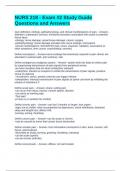NURS 218 - Exam #2 Study Guide
Questions and Answers
Give definition, etiology, pathophysiology, and clinical manifestations of pain. - Answer--
definition: unpleasant, sensory, emotional sensation associated with actual or potential
tissue injury
-etiology: nerve damage, actual tissue damage, cancer, surgery
-pathophysiology: tissue damage activates free nerve endings, nociceptors
-clinical manifestations: SOCRATES (site, onset, character, radiation, association w/
other symptoms, time course, exacerbating, severity)
Define nociceptors. - Answer-nerve endings that selectively respond to pain stimuli, are
abundant in arterial walls, joint surfaces, skin
Define endogenous analgesia system. - Answer--system built into body to relieve pain
by suppressing transmission of pain signals from peripheral nerves
-we have receptors that act when endorphins released
-endorphins: interact w/ receptors to inhibit the transmission of pain signals, produce
sense of euphoria
>excitement, stress, aerobic exercise can trigger release
-enkephalins: interrupt transmission of pain signals at spinal cord level by inhibiting the
release of substance P
Define acute pain. - Answer--sharp, cutting pain
-can occur from injury, trauma, muscle spasm, disease
-can serve as warning sign
-"fast pain"
-pt may cry or position for comfort
Define chronic pain. - Answer--can last 3 months or longer, less urgent
-signs not as visible, often accompanies by depression, social withdrawal, disturbed
sleep and weight loss, affects ADL
-burning, aching, throbbing
Define cancer pain. - Answer--can be acute or chronic
-may be caused by tumor that causes tissue destruction
Define somatic pain. - Answer--from stimulation nociceptors in skin, bone, muscle, soft
tissue, well localized
-described as sharp, burning, gnawing, throbbing, cramping
-can be acute (sprain)
-can be chronic (arthritis)
Define visceral pain. - Answer--diffuse, not well located
, -nociceptors stimulated in area and their surrounding tissues
-pt may describe as in large area
-pancreatitis complains of abominal pain
Define neuropathic pain. - Answer--injury to nerves
-pain receptors, or CNS
-diabetics complain bc high glucose levels can lead to nerve injury
-burning, buzzing pain
-difficult to treat bc analgesics less effective in neuropathic pain
Define breakthrough pain. - Answer--pain in between doses of pain medication
-often cancer pts
Give action, use, adverse effects, and contraindications for morphine sulfate
(Duramorph, MS Contin). - Answer--class: opioid agonist
-action: binds to receptors in brain, spinal cord, and peripheral tissues (primarily mu
receptors), act like gates that close transmission of pain impulses from neuron to
neuron, activate endo. analgesia system
-use: prevent/relieve acut or chronic pain, surgery, labor and delivery, etc.
-adverse effects: CNS depression (drowsiness/sleep/unconscious), decreased mental +
physical activity, respiratory depression!!, N/V, miosis, constipation
-contraindications: existing respiratory dep., lung disease, head trauma
Identify nursing interventions related to the use of patient-controlled analgesia. -
Answer--prescribers order and nurses set up
-only pt. presses button
-still assess pain (0-10), how alert pt is
-look at pump to see how much/often pt presses button
-program lockout period
-prevent interactions:
>alcohol + antidepressants: increase drowsiness, res. distress
>narcotics: hypotension, res. dep., coma
Discuss the treatment of opioid overdose and the management of withdrawal
symptoms. - Answer--primary signs of overdose: respiratory depression, coma, can lead
to death
-withdrawal signs: anxiety, insomnia, pupil dilation
-can occur with therapeutic dose
-SAVEME: stimulate, airway, ventilate, evaluate, muscular injection (naloxone),
evaluate
Give action, use, adverse effects, and contraindications for butorphanol. - Answer--
class: opioid agonist/antagonist
-action: agonist of kappa receptors and partial agonist of mu receptors, cause inhibition
of ascending pain pathways
-use: moderate to severe pain




